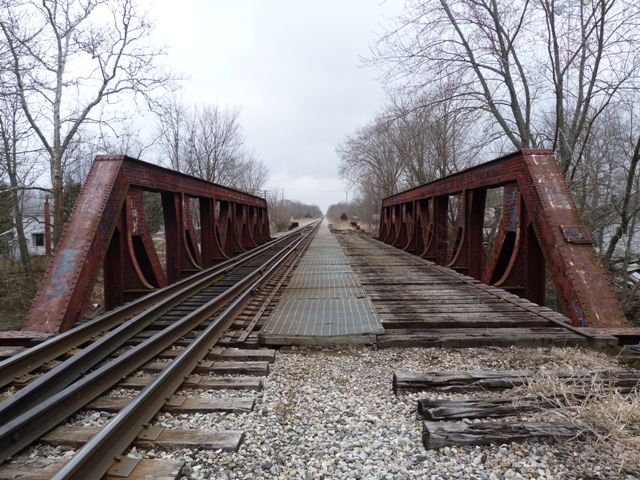We Recommend:
Bach Steel - Experts at historic truss bridge restoration.
BridgeHunter.com Phase 1 is released to the public! - Visit Now
Plymouth Railroad Bridge
Pennsylvania Railroad Yellow River Bridge

Primary Photographer(s): Nathan Holth
Bridge Documented: March 4, 2012 and January 24, 2022
Plymouth: Marshall County, Indiana: United States
1902 By Builder/Contractor: American Bridge Company of New York, New York
Not Available or Not Applicable
Not Available
Not Available
Not Available
1 Main Span(s)
Not Applicable

View Information About HSR Ratings
Bridge Documentation
View Archived National Bridge Inventory Report - Has Additional Details and Evaluation
This bridge is an uncommon example of a railroad pony truss. Through truss bridges and girder bridges are more common. Carrying one track, but designed for two, this bridge has very massive trusses to enable it to support the two track load. The bridge was built in 1902, and as such is a very early example of a bridge built by this very prolific bridge builder, since American Bridge had only been in operation for a couple years.
Information and Findings From DHPA Historic Bridge SurveyStatement of Significance A national company quite successful with a multitude of railroad contracts erected this bridge. Few, indeed, were the Pratt pony spans built on Indiana's rail system, and this one is among the earliest examples extant. The riveting, the full-hip design, the crafting of heavy members, and the stiffeners all bespeak the designer's will to fashion a span with unusual load-bearing capabilities. Architectural Description The American Bridge Company of New York erected this single-span, riveted, and full-hip Pratt pony upon cut-stone abutments. Each of the trusses has eight panels. The endposts and top chords are heavy: crafted channels carry additional reinforcing plates. A pair of channels riveted together iwth cover plates provide substantial lower-chord members, too. All the verticals, diagonals, and counters are made from crafted I-beams. Only the two most central panels are countered. Riveted to gussets and the verticals above the lower chord, heavy girder floor beams carry ties for two rail tracks. Arced stiffeners extend across the inner flanges of the verticals to the tops of the floor beams. Bridge Considered Historic By Survey: Yes |
This bridge is tagged with the following special condition(s): Unorganized Photos
![]()
Photo Galleries and Videos: Plymouth Railroad Bridge
Bridge Photo-Documentation
Original / Full Size PhotosA collection of overview and detail photos. This gallery offers photos in the highest available resolution and file size in a touch-friendly popup viewer.
Alternatively, Browse Without Using Viewer
![]()
Bridge Photo-Documentation
Mobile Optimized PhotosA collection of overview and detail photos. This gallery features data-friendly, fast-loading photos in a touch-friendly popup viewer.
Alternatively, Browse Without Using Viewer
![]()
Additional Unorganized Photos
Original / Full Size PhotosA supplemental collection of photos that are from additional visit(s) to the bridge and have not been organized or captioned. This gallery offers photos in the highest available resolution and file size in a touch-friendly popup viewer.
Alternatively, Browse Without Using Viewer
![]()
Additional Unorganized Photos
Mobile Optimized PhotosA supplemental collection of photos that are from additional visit(s) to the bridge and have not been organized or captioned. This gallery features data-friendly, fast-loading photos in a touch-friendly popup viewer.
Alternatively, Browse Without Using Viewer
![]()
Maps and Links: Plymouth Railroad Bridge
Coordinates (Latitude, Longitude):
Search For Additional Bridge Listings:
Bridgehunter.com: View listed bridges within 0.5 miles (0.8 kilometers) of this bridge.
Bridgehunter.com: View listed bridges within 10 miles (16 kilometers) of this bridge.
Additional Maps:
Google Streetview (If Available)
GeoHack (Additional Links and Coordinates)
Apple Maps (Via DuckDuckGo Search)
Apple Maps (Apple devices only)
Android: Open Location In Your Map or GPS App
Flickr Gallery (Find Nearby Photos)
Wikimedia Commons (Find Nearby Photos)
Directions Via Sygic For Android
Directions Via Sygic For iOS and Android Dolphin Browser
USGS National Map (United States Only)
Historical USGS Topo Maps (United States Only)
Historic Aerials (United States Only)
CalTopo Maps (United States Only)


